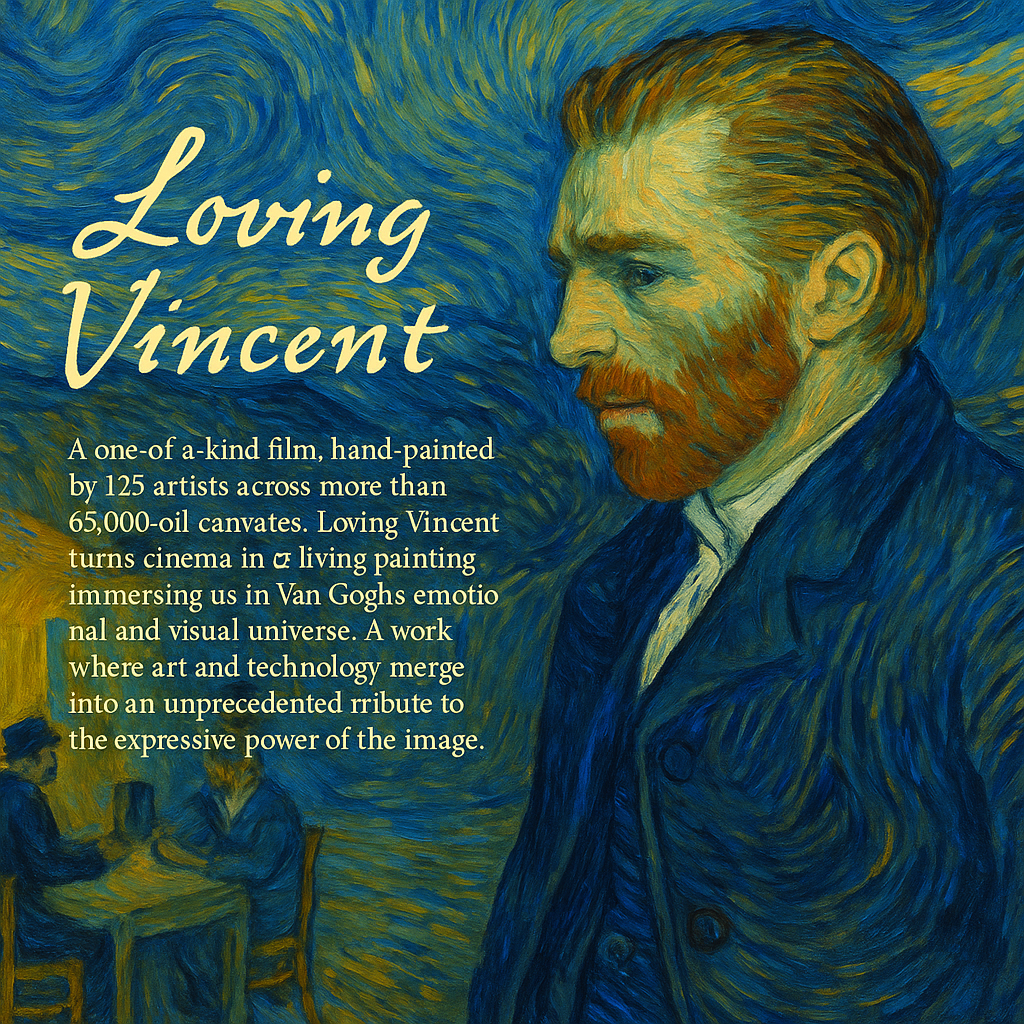Loving Vincent
A one-of-a-kind film, hand-painted by 125 artists across more than 65,000 oil canvases. Loving Vincent turns cinema into living painting, immersing us in Van Gogh’s emotional and visual universe. A work where art and technology merge into an unprecedented tribute to the expressive power of the image.
CIACK D'ATELIER
Charlotte Madeleine CASTELLI
7/27/20253 min read


Loving Vincent: When Cinema Becomes a Living Canvas of Van Gogh’s Soul
When cinema embraces art so profoundly that each frame transforms into a brushstroke, the result is no mere film but a vibrant, breathing artwork. Loving Vincent is precisely this rare alchemy: a thriller woven entirely from oil paintings, each frame painstakingly hand-painted by over one hundred artists, resurrecting the tormented yet radiant world of Vincent van Gogh in a way never before seen. This ambitious endeavor, initiated six years ago by Polish painter and filmmaker Dorota Kobiela and British director Hugh Welchman, invites the viewer into a cinematic noir that retraces the enigmatic last weeks of the Dutch master’s life in Arles, 1888.
Van Gogh’s life story, often shrouded in myth and tragedy, is here refracted through the flickering light of his own palette. The young Armand Roulin, son of the postman Joseph Roulin—himself immortalized in Van Gogh’s paintings—embarks on a quest to deliver a final letter from the artist to his brother, uncovering a community bound by friendship, mystery, and grief. Figures such as Adeline, Van Gogh’s landlady, Père Tanguy, and the enigmatic Dr. Paul Gachet are rendered with vivid strokes, breathing life into a cast that emerges from the very canvas of history.
What distinguishes Loving Vincent is not simply its narrative but its pioneering technique: over 65,000 frames created as individual oil paintings, animated through the innovative Painting Animation Work Stations (PAWS). This technology fused live-action footage with classical oil painting techniques, enabling 125 artists from around the globe to paint over projected images, blending cinematic movement with the textured tactility of Van Gogh’s impasto. Each frame took roughly forty minutes to complete, often requiring artists to revisit their canvases dozens of times to capture the painter’s signature fluidity and vibrant color.
The film’s aesthetic oscillates between vivid color and stark black-and-white, underscoring the liminal space between memory and reality, presence and absence—mirroring Van Gogh’s own oscillations between light and shadow, hope and despair. The yellow house, the wheat fields, the blue irises, and the solitary chair become immersive spaces where the artist’s vision is not simply depicted but inhabited. This cinematic oeuvre becomes a moving gallery, each frame a dialogue between image and time, between the ephemeral act of painting and the permanence of film.
Kobiela’s initial inspiration sprang from her profound engagement with Van Gogh’s letters—texts that reveal the artist’s intimate struggles and relentless devotion to art beyond his mythologized madness. The letters serve as a poetic scaffold for the screenplay, infusing the film with a deeply humanist sensibility that transcends biographical reductionism. Rather than dwelling on illness, Loving Vincent probes the transformative power of creativity itself, crafting a story told through the very medium Van Gogh lived and breathed.
Welchman’s journey from animation producer to collaborator was propelled by a recognition of the public’s enduring fascination with Van Gogh’s life and art. The production, supported by major international institutions including the Polish Film Institute and the Van Gogh Museum, navigated logistical challenges with remarkable ingenuity, turning a labor-intensive analogue process into a modern masterpiece. The project’s virality—its trailer viewed millions of times—underscores how audiences remain hungry for authentic encounters between art and cinema.
Loving Vincent is more than a technical tour de force; it is a manifesto for the sensory and material possibilities of film. By slowing down cinematic time to the rhythm of brushstrokes, it invites audiences into a multisensory experience where texture and light dissolve conventional narrative pacing. It challenges the dominance of digital smoothness by privileging the corporeal presence of oil paint—its thickness, its shine, its capacity to reflect the artist’s hand.
The film’s reception confirms its cultural significance. Garnering nominations at the Academy Awards, BAFTA, and Golden Globes, alongside wins at the Annecy Festival and European Film Awards, Loving Vincent occupies a liminal space between popular fascination and high artistic ambition. It is a touchstone for contemporary dialogues about authorship, collaboration, and the materiality of image-making, recalling how the collective labor of its painters parallels Van Gogh’s own exhaustive work ethic. This film exemplifies the fertile intersection of art and cinema—where the moving image becomes a living painting, and painting becomes a temporal journey. It invites reflection on how film can transcend narrative to become an exhibition in time, a gallery of color and emotion brought to life through human touch.
In essence, Loving Vincent does not merely depict Van Gogh’s world—it revives it as a sensorial, immersive dimension. It embodies the fragile beauty and relentless passion of the artist’s gaze, animating history with paint, light, and cinematic memory. Presented within the dialogue between film and fine art, Loving Vincent stands as an unparalleled testimony to the enduring power of creative vision, and the infinite possibilities that emerge when disciplines merge in poetic devotion.
© Charlotte Madeleine Castelli | All rights reserved
